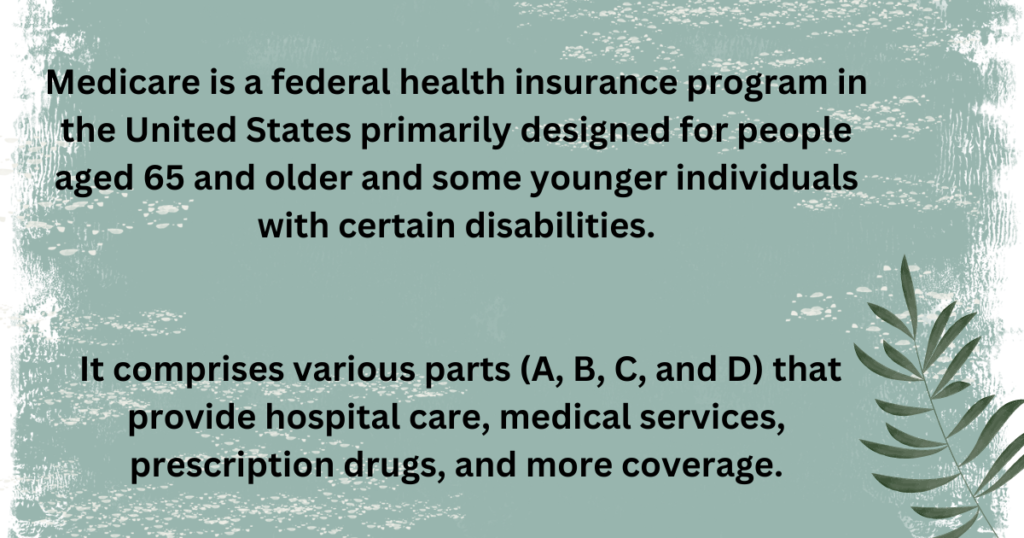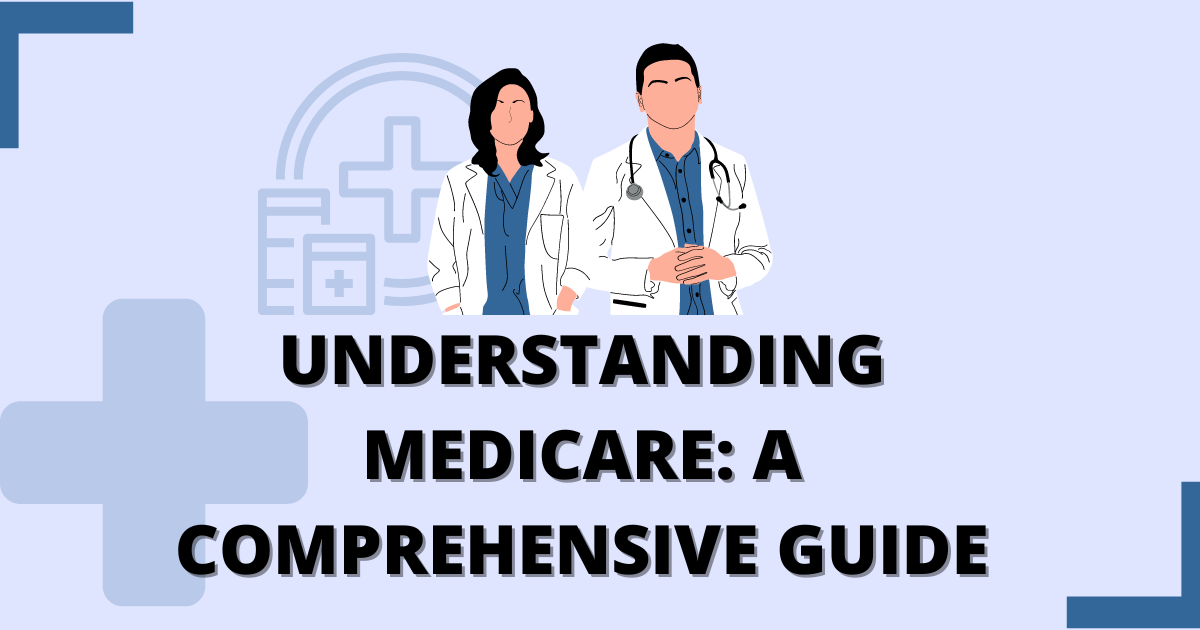Medicare is a federal health insurance program that primarily serves people aged 65 and older. However, younger individuals with certain disabilities and those with End-Stage Renal Disease (ESRD) or Amyotrophic Lateral Sclerosis (ALS) also qualify. This guide will take you through everything you need to know about Medicare, from eligibility to coverage options, costs, and how to make the best decisions for your healthcare needs.
1. What is Medicare?
Medicare was established in 1965 as part of the Social Security Amendments to provide affordable healthcare for older Americans and those with qualifying disabilities. The program is divided into several parts that cover different healthcare services:

- Medicare Part A (Hospital Insurance): Covers inpatient hospital stays, care in a skilled nursing facility, hospice care, and some home healthcare.
- Medicare Part B (Medical Insurance): Covers outpatient care, doctors’ services, preventive services, and medical supplies.
- Medicare Part C (Medicare Advantage Plans): An alternative to Original Medicare, offered by private insurance companies approved by Medicare.
- Medicare Part D (Prescription Drug Coverage): Provides coverage for prescription medications.
Each part of Medicare serves a unique role, offering a range of benefits tailored to various health needs.
2. Who Is Eligible for Medicare?
Medicare eligibility is largely based on age, though other factors may qualify you for coverage before age 65. Below are the primary eligibility criteria:
- Age-Based Eligibility: Individuals aged 65 or older who are U.S. citizens or permanent residents are eligible.
- Disability: If you are under 65 and have been receiving Social Security Disability Insurance (SSDI) for 24 months, you automatically qualify.
- End-Stage Renal Disease (ESRD) and ALS: People with these conditions are eligible for Medicare regardless of age.
3. How to Enroll in Medicare
Enrolling in Medicare can feel overwhelming, especially with multiple parts to consider. Here’s a step-by-step guide to help you navigate the process:
- Initial Enrollment Period (IEP): This seven-month window begins three months before your 65th birthday, includes your birth month, and ends three months after.
- General Enrollment Period: If you miss your IEP, you can enroll between January 1 and March 31, but coverage will not begin until July 1 of that year.
- Special Enrollment Period: If you’re still working and covered under an employer-sponsored health plan, you may qualify for a Special Enrollment Period without penalty.
4. The Different Parts of Medicare Explained
Medicare Part A: Hospital Insurance
Medicare Part A helps cover the cost of inpatient hospital stays, skilled nursing facility care, hospice care, and some home healthcare services. Most people do not pay a premium for Part A, as they have already paid Medicare taxes while working. However, if you haven’t worked long enough to qualify for premium-free Part A, you may have to pay a premium.
Medicare Part B: Medical Insurance
Medicare Part B covers medically necessary services and preventive care. This includes visits to your doctor, outpatient services, mental health care, and durable medical equipment. Unlike Part A, most beneficiaries must pay a monthly premium for Part B, which is based on your income.
- Preventive services covered by Part B include flu shots, cancer screenings, cardiovascular disease screenings, and more.
- Medically necessary services like diagnostic tests, treatments, and therapy are also included.
Medicare Part C: Medicare Advantage Plans
Medicare Advantage Plans are an alternative way to receive Medicare benefits. These plans are offered by private insurance companies and often include additional services such as vision, dental, and hearing coverage. Most Medicare Advantage plans also bundle Part D prescription drug coverage.
However, while Medicare Advantage Plans may offer more comprehensive coverage, they often require you to use a network of providers. It’s important to compare plan options to find the best fit for your needs.
Medicare Part D: Prescription Drug Coverage
Medicare Part D helps cover the cost of prescription medications. These plans are offered by private insurers and are either standalone policies or included in Medicare Advantage Plans. It’s important to enroll in Part D when you’re first eligible to avoid late enrollment penalties.
Each Part D plan has a formulary, a list of covered drugs. It’s essential to choose a plan that includes the medications you regularly take to avoid out-of-pocket expenses.
5. How Much Does Medicare Cost?
Medicare costs vary depending on the coverage you choose and your income. Here’s a breakdown of the typical costs:
- Medicare Part A: Most people qualify for premium-free Part A. However, if you need to buy Part A, the premium can range from $278 to $506 per month in 2024. There is also a deductible of $1,600 per benefit period for hospital stays.
- Medicare Part B: The standard Part B premium for 2024 is $174.70 per month. However, higher-income individuals may pay more through the Income-Related Monthly Adjustment Amount (IRMAA).
- Medicare Part C: Medicare Advantage plans have varying costs depending on the specific plan, with some offering $0 premiums. However, you may still need to pay Part B premiums.
- Medicare Part D: Prescription drug plans vary, with monthly premiums typically ranging from $15 to $80.
6. Common Medicare Mistakes to Avoid
Navigating Medicare can be tricky, and it’s easy to make mistakes that could lead to higher costs or gaps in coverage. Here are some common pitfalls:
- Missing the Enrollment Period: If you don’t enroll in Medicare during your Initial Enrollment Period, you may face lifelong late enrollment penalties.
- Not Understanding Part D Penalties: Failing to enroll in a prescription drug plan when first eligible can lead to a late enrollment penalty, even if you don’t take any medications.
- Assuming Medicare Covers Everything: Medicare doesn’t cover everything, including most dental, vision, and long-term care costs.
- Not Reviewing Your Coverage Annually: Medicare Advantage and Part D plans can change from year to year. It’s essential to review your plan annually during the Open Enrollment Period to ensure it still meets your needs.
7. Medicare and Medicaid: What’s the Difference?
While both Medicare and Medicaid provide healthcare coverage, they serve different populations and have different eligibility requirements:
- Medicare is primarily for people aged 65 or older and some younger individuals with disabilities.
- Medicaid is a joint federal and state program that provides healthcare for low-income individuals of any age.
Some people qualify for both programs, a situation known as dual eligibility, which can help cover costs that Medicare doesn’t, such as long-term care and out-of-pocket expenses.
8. Medicare Supplements (Medigap)
Original Medicare (Parts A and B) covers many healthcare services, but it also leaves some gaps, such as deductibles, copayments, and coinsurance. Medigap is supplemental insurance offered by private companies to help cover these out-of-pocket costs.
Medigap plans come in 10 standardized versions (Plan A, B, C, D, F, G, K, L, M, and N) offering different levels of coverage. Choosing the right Medigap plan requires a good understanding of your healthcare needs and financial situation.
9. Medicare Advantage vs. Medigap: Which is Right for You?
Both Medicare Advantage and Medigap offer ways to enhance your Medicare coverage, but they work in very different ways. Here’s a comparison:
- Medicare Advantage plans are all-in-one alternatives to Original Medicare, often including Part D and extra benefits like dental or vision. They may have lower premiums but typically require you to use a network of doctors and hospitals.
- Medigap is supplemental insurance that works alongside Original Medicare to cover out-of-pocket costs. Medigap offers more flexibility in choosing providers but requires separate Part D coverage.
The choice between Medicare Advantage and Medigap depends on your personal healthcare needs, budget, and preferred level of flexibility in choosing healthcare providers.
10. Future of Medicare: What’s Next?
Medicare is a cornerstone of American healthcare, but its future is uncertain. Rising healthcare costs, the aging population, and legislative changes all impact the program’s sustainability. Here are a few trends to watch:
- Telehealth Expansion: Medicare has increased its coverage for telehealth services, a change that may continue as technology improves and the demand for remote care grows.
- Prescription Drug Reform: High drug prices remain a concern for Medicare beneficiaries, and reforms to reduce costs may be on the horizon.
- Medicare Funding Challenges: As the number of Medicare beneficiaries grows, the program faces funding challenges. Policymakers will need to find solutions to ensure its long-term viability.
Conclusion
Medicare plays a vital role in providing health insurance to millions of Americans. Understanding its different parts, enrollment options, and associated costs is essential for making informed decisions about your healthcare. Whether you’re nearing 65 or assisting a loved one, knowing the ins and outs of Medicare will help you navigate the complexities of the program and choose the best options for your situation.

[…] Medicaid is a joint federal and state program that provides health coverage to low-income individuals, families, children, pregnant women, elderly adults, and people with disabilities. It was created under the Social Security Act in 1965, along with Medicare, as part of the federal government’s efforts to provide healthcare assistance to the most vulnerable populations in the U.S. […]